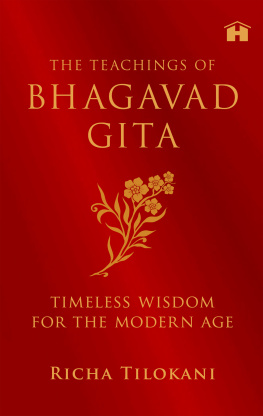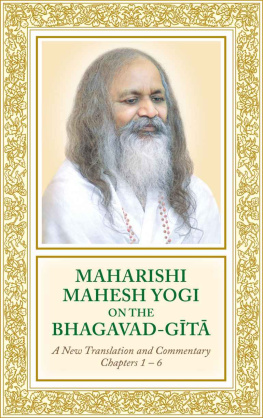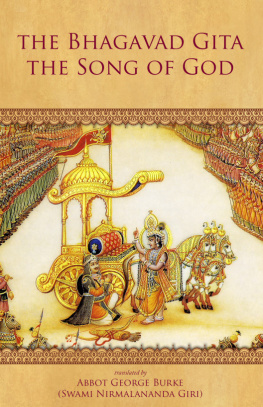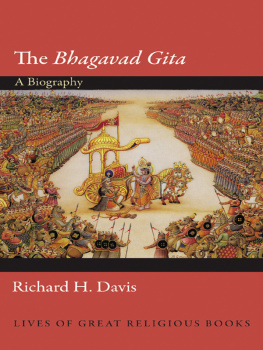The Bhagavad Gita for Awakening
A Practical Commentary for Leading a Successful Spiritual Life
Abbot George Burke (Swami Nirmalananda Giri)

Light of the Spirit Press
Cedar Crest, New Mexico
Contents
Published by
Light of the Spirit Press
lightofthespiritpress.com
Light of the Spirit Monastery
P. O. Box 1370
Cedar Crest, New Mexico 87008
www.ocoy.org
Copyright 2018 Light of the Spirit Monastery.
All rights reserved.
Light of the Spirit Press, Cedar Crest, New Mexico
Translation of the Bhagavad Gita used in this book from
The Bhagavad Gita: The Song of God by Abbot George Burke.
Copyright 2018 Light of the Spirit Monastery.
1. SEL032000 SELF-HELP / Spiritual
2. REL032030 RELIGION / Hinduism / Sacred Writings
First edition, (December 2018)
Credits: The cover contains an illustration of Krisha and Arjuna on the Battlefield of Kurukshetra based on a painting by the Rajasthani artist Bhanwar lal Girdhari lal Sharma
Bhagavad GitaThe Book of Life
S everal thousand years ago in north-central India, two people sat in a chariot in the midpoint of a great battlefield. One of them, the yogi Arjuna, knew that it would be not be long before the conflict would begin. So he asked Krishna, the Master of Yoga (Yogeshwara), what should be his attitude and perspective in this moment. And above all: What should he do?
There was no time to spare in empty words. In a brief discourse, later turned into seven hundred Sanskrit verses by the sage Vyasa, Krishna outlined to Arjuna the way to live ones entire life so as to gain perfect self-knowledge and self-mastery.
The battle was ferocious andas always with wareveryone lost. But when Vyasa wrote his epic poem, the Mahabharata (The Great Indian War), he put Krishnas inspired teachings into it as a precious jewel. Instantly they were extracted, named Bhagavad Gita (The Song of God), and circulated throughout the subcontinent.
That was several thousand years ago, and today the Gita is found in nearly every household in India and has been translated into every major language of the world. Literally billions of copies have been handwritten and printed. (A few years ago a spiritual organization in South Africa printed one million copies for free distribution.) When Rudyard Kipling became a Freemason in Lahore, four scriptures were on the altar, including the Bhagavad Gita.
What is the appeal of the Gita? First of all, it is totally practical, free of any vague or abstract philosophy. During my first trip to India over forty years ago, I heard about a yogi who lived in a small houseboat on the Ganges river in the holy city of Benares (Varanasi). He never spoke or wrote, yet every day for many years people came to him for advice. How did he manage? He had a copy of the Bhagavad Gita, and after he was told the problem or question he would open the book, point to a portion, and the inquirer would have a perfect and complete solution to the trouble.
My own spiritual awakening began by kicking me out of the nest of comfortable religion into a vast world of realities I had no idea how to cope with. I floundered around in the sea of my new horizons until one day I bought a paperback edition of the Bhagavad Gita. I did not read it, I inhaled it. I was not reading the words of a long-dead teacher: my own Self was talking to me in the pages of that little book. Nor did I learn anything from the GitaI remembered that which I had always known. Eternal Self spoke Eternal Truth. The Bhagavad Gita changed my life by giving me Life that has never ended.
Nothing has ever arisen in my life, internal or external, that the Gita has not made clear and enabled me to deal with or understand. Yet is it not dogmatic. At the very end Krishna says to Arjuna: Now I have taught you that wisdom which is the secret of secrets. Ponder it carefully. Then act as you think best. No threats, no promises, no coercion. It is all in the reader s hands.
Even better: the Bhagavad Gita tells us that we can attain a Knowing beyond even what it tells us. And it shows us the way. It is a wise resolve to read the Gita every day without fail for the rest of one s life.
A practical suggestion
The translation used in this commentary is my own, but I recommend that you obtain other translations of the Gita, for it is impossible to produce a definitive translation of a text written in such a complex language as Sanskrit. I always check at least four translations when looking into the meaning of a verse: those of Swamis Prabhavananda, Swarupananda, Sivananda, and that of Winthrop Sargeant. I sometimes consult those of Sri Aurobindo, Gandhi, and William Judge, as well.
I would like to point out that reading any English-only translation of the Gita, however good, will only be skimming the surface. This is because of the many meanings of Sanskrit wordsmeanings that were in the mind of Vyasa and that were used for that very reason. In the West we have the idea that spiritual texts have but one meaning, and that may be so for some, but this is not at all the case for Sanskrit texts which are intended to have multi-level messages and subtle nuances. Words which carry several relevant ideas are ideal for the profound wisdom of the Gita and Upanishads, particularly.
In the Gita translation, words in parentheses indicate alternate readings of the actual Sanskrit word preceding them. Those alternate readings are as legitimate as the English term I have used. Brackets indicate words not in the Sanskrit text but inserted by me to clarify the meaning.
Because of this I recommend that you obtain translations of the Gita that contain the Sanskrit text with word-by-word translations as well as the usual verse form. Sargeants translation is definitely the best for this, but it would be good to have one or two more. In addition you need some Sanskrit dictionaries. I recommend: A Concise Dictionary of Indian Philosophy by John Grimes, The Yoga-Vedanta Dictionary of Swami Sivananda, Sanskrit Glossary of Yogic Terms by Swami Yogakanti and A Sanskrit Dictionary by John M. Denton. My own endeavor, A Brief Sanskrit Glossary, is certainly helpful, and definitely complements them.
Swami Nirmalananda Giri
(Abbot George Burke)

The Battlefield of the Mind
M ost of us have heard the story of the centipede who, when asked how he managed to walk with so many legs, tangled his legs in the attempt to figure it out and ended up on his back, helpless. This is not unlike the person who attempts to plumb the depths of oriental scriptures. Right away it becomes evident that they consist of incalculable layers, many symbolic in nature. Furthermore, the meanings of the symbols are not consistent, changing according to the levels on which they occur. For example, on one level water symbolizes the mind, on another level the constant flux of samsara, and on another the subtle life-currents known as prana. This being the case, the Western linear mode of thought becomes as entangled and disabled as the fabled centipede. Knowing this to be so, I have decided to avoid subtle symbolism and concentrate instead on the obviously practical side of Krishnas teachings in the Bhagavad Gita. (For an exposition of the symbolism of the Gita, see Paramhansa Yoganandas commentary, God Talks With Arjuna: The Bhagavad Gita .) However I do want to take some time and consider the obvious symbolism encountered in the first chapter of the Gita.
Next page










